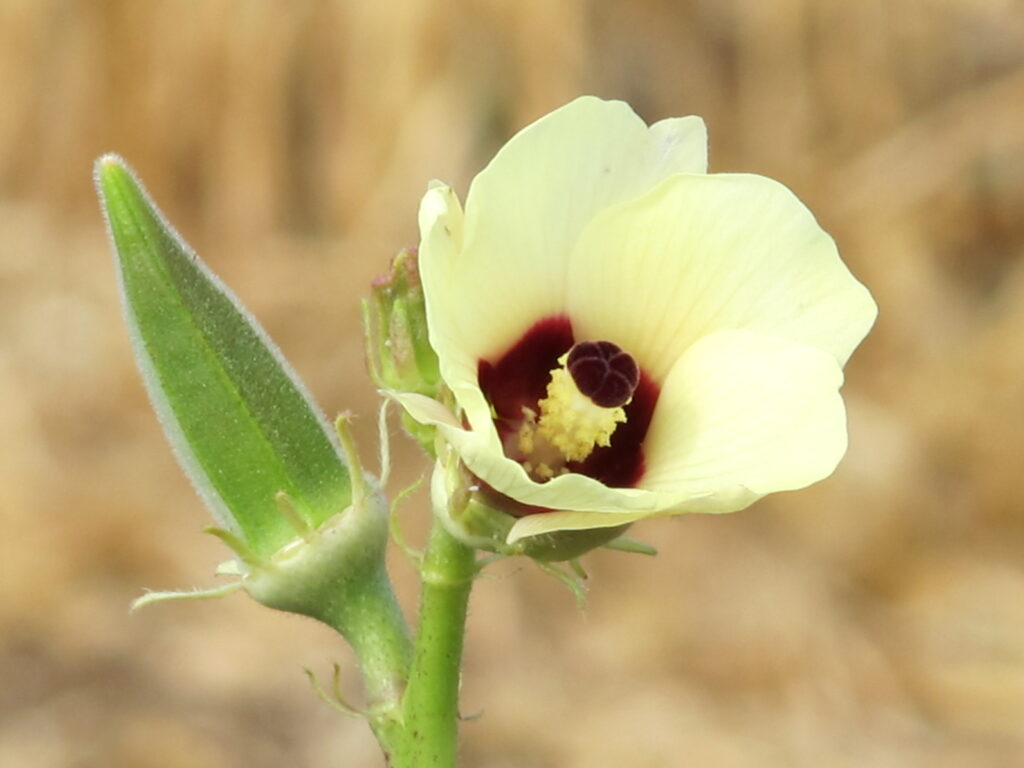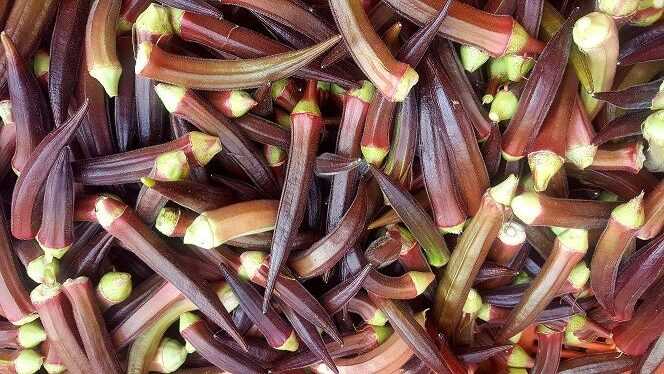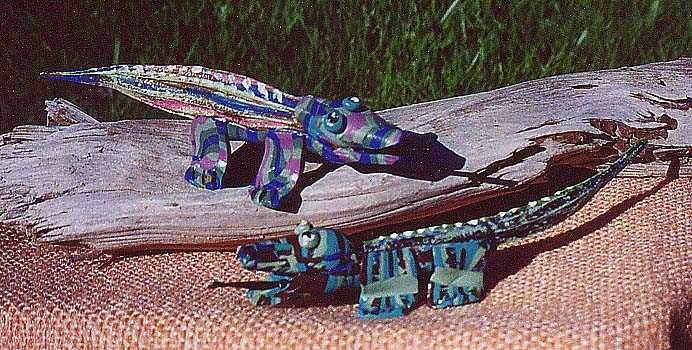The myth is that people of Ashkenazi origin can’t tolerate okra and do not appreciate it, but as a descendent of a German father who can eat okra for all three meals daily, I can vouch for the fallacy of this myth. At our house too, okra is very much loved, and makes us happy every summer. Versatile as ever, okra can be crispy, stir-fried in lemon, tender in tomato sauce, roasted in the oven or chopped up raw to become little “stars” in a salad.
Okra likes to prance around using her fancy name “Lady Fingers,” indicating that she must be treated with gentle respect: Before cooking it, the tip must be gently cut off, taking care not to hurt the pod. In olden times, when a groom’s family wanted to “check out” a bride, they handed her a knife, a pile of okra, and put her to work. If she was able to properly slice it, this meant she was gentle and skilled.
But to the harvesters, okra does not put on her dainty lady show. The branches of the okra bush contain etheric oil and any brush against them causes a terrible itch, which is why okra is harvested wearing long sleeves and gloves. This crop is harvested in large quantities, and we visit the okra beds every other day so as not to find ourselves standing in front of a lady who totally forgot to trim her fingernails… Harvesting takes a really long time, as the pods must be searched for among the tangled brush of foliage and then picked one by one. Very personal treatment.
But although she is royalty, okra is also one of the only crops which does not force us to kneel down before them. The bushes quickly grow taller, reaching an impressive height of 3 meters! At that point, it is already way above us and we must bend its flexible branches in order to reach its pods. Another thing that makes us happy when we harvest okra is the beauty of its flowers. Okra belongs to the Malvaceae family (along with the chubeza, cotton, hibiscus and hollyhock). Not many members of the family are edible, but they are indeed rather beautiful. Our okra boasts large, lush yellowish flowers, with a vivid purple center.

Okra began its domesticated path in the world over 1,000 years ago in tropical Africa, in the Ethiopia-Eritrea-Sudan area, where it can still be found growing wild today. From there it crossed the Red Sea to Saudi Arabia and took off to North Africa, the Middle East and India. It is not clear how this journey occurred, and there are very mysterious periods within okra history, but it became a unanimously loved food in all those countries. Okra arrived in Europe, compliments of the Muslim Moors in the 12th century. It made its debut in the new continent, America, via two sources: African slaves brought to work in the colonial colonies carried okra to Brazil and South America, and simultaneously French settlers, who knew it from Europe, brought it to Louisiana. Over the past decades okra became a vaunted vegetable in the Asian kitchen, specifically the Japanese. So one does not have to be Egyptian or Greek to hold this vegetable in esteem.
The local okra variety indigenous to Israel has small – even tiny – pods. Traditionally you’ll be told to steer clear of a pod larger than your pinky, as this is a sign of an okra which is over-mature and too fibrous. On the contrary, the green and red okra variety that Chubeza grows is the Thai okra: longer, bigger and a little less slimy. Don’t be put off by the size – it’s simply a different cousin, but not any less amazing than other family members. If I dare say so myself, in many recipes it’s even better!
(Thanks you, Dafna. for the beautiful picture)

But despite its beauty and my father’s deep affection for it, some people are repulsed by the modest okra. The reason generally cited is its “texture,” or in other words: “that slimy stuff that oozes out when it’s cooked.” That’s a pity, because that “slimy stuff” holds the okra in its Cinderella state, still in rags, waiting to be discovered for all its charms. There are many ways to reduce the slime, which I will get to soon, but let us first discover the charms of Cinderella.
One of the most amazing things about okra is that it can be used in a great variety of ways, some of which aren’t fully utilized today. We usually cook, roast or fry the young pods (3-5 days old), which is, of course, great. They are rich in vitamins K, A and C, plus folic acid, calcium, magnesium and potassium. The dietary fibers aid in preventing constipation and in stabilizing blood sugar levels by slowing down the process of sugar absorption in the digestive system. Okra also absorbs cholesterol and removes stomach acids containing the toxins that did not pass through the liver’s filtering system. Its dietary fibers are unique in that they feed the good intestinal flora. As it matures, okra’s fibers grow more and more rigid (which anyone who ever tried to chew a mature pod can attest to) and hold an unfulfilled potential as raw material for the rope and paper industry.
Yet its assets are not only in the pod fibers, but also in its little seeds: the oil produced from them is quite healthy and unsaturated, with characteristics resembling the lauded olive oil. The tiny seeds contain vegetal protein, like soybeans, and they are rich in tryptophan and contain amino acids- a very important combination for vegetarians. Ground okra seeds were used in the past (and in some places, in the present) as caffeine-free substitutes for coffee, like the chicory root.
So what about that “slime”? It, too, can be efficiently used to thicken soups and other dishes (sometimes okra pods are dried and ground to be used for thickening, similar to gelatin) and some say it can be beneficial to heal wounds and soothe burns, like the gel inside the aloe vera plant.
But if you still wish to reduce the slime level in cooking, there are several options:
– Leave the pod whole (cut off the stem, but do not open the pod)
– Prepare quickly and easily by stir-frying or frying, not by lengthy cooking in liquids.
_ Roast it! Rinse and dry the okra with a towel. Trim off the stems and tips, place in a bowl and drizzle with olive oil and some salt. Place okra on a foil-lined cookie sheet or oven pan and roast in a hot oven for around 15 minutes, stirring the okra every 5 minutes. Serve warm.
– Combine with acidic foods: tomatoes, lemon juice or vinegar.
Another surprising and attractive use for okra is in arts and crafts. Okra pods make fancy dragons, or can be cut horizontally to become delicate star-shaped stampers. Note the pictures:


This week is a week of holidays, the Muslim Eid El Adha, and the Thai Queen day. We’d like to wish happy holidays to our celebrating workers
Due to the holiday vacations, some young workers (on school break) came to help pack your veggies – thank you to Netta, Matan, Shahar and Talya!
Alon, Bat Ami, Dror, Orin, Yochay and the entire Chubeza team
________________________________________
WHAT’S IN THIS WEEK’S BOXES?
Monday: Okra, lettuce/potatoes, onions, eggplants, cucumbers, tomatoes, Thai long beans, A slice of pumpkin, parsley/cilantro, cherry tomatoes, peppers.
Large box, in addition: Corn, Amoro/butternut pumpkin, New Zealand spinach.
Fruit box: Apples, grapes, pear. Small boxes: Banana. Large boxes: Nectarine.
Wednesday: Okra/potatoes, onions, eggplants, cucumbers, tomatoes, Thai long beans, A slice of pumpkin, parsley, cherry tomatoes, Amoro/butternut pumpkin, peppers.
Large box, in addition: New Zealand spinach, garlic/scallions, cilantro.
Fruit box: Apples, nectarine, pear. Small boxes: Banana. Large boxes: Grapes.
